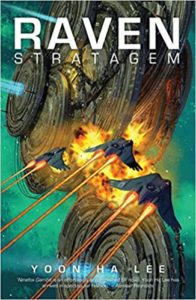Raven Stratagem picks up right where Ninefox Gambit left off, with the star-spanning hexarchate facing threats from within and without: internal heretics who threaten to disrupt the tight control of time that enables faster-than-light travel and other sufficiently advanced technologies, external aliens bent on conquest. A swarm sent by Kel Command, the highest authority of the hexarchate’s warrior caste, to defend against the invasion has received orders to stop and pick up a passenger in a solo ship, one Captain Kel Cheris. She was the hero of Ninefox Gambit, and readers know something that the officer of the swarm, from whose point of view the initial chapter of Raven Stratagem is told, does not: her body is also home to General Shuos Jedao, a master tactician who is also a loose cannon, and whose commitment to the hexarchate is more than a little in doubt.
The crew soon has cause to regret the oversight, as it is Jedao who boards the command ship, using his high rank and the Kel instinct for obedience to commandeer the whole swarm. With that, Raven Stratagem is off to the races. The story moves quickly, and now that the hexarchate was more familiar to me after Ninefox Gambit, I zipped right along with it. Narrative tension builds along several lines: Will Jedao be able to stop the invasion before Kel Command removes him from the swarm that he has stolen? Does he actually intend to stop the invasion, or is he playing a double game? Does Kel Command actually want to remove him? Do they want the invasion fully stopped? What sort of double game might they be playing? Given how oppressive the hexarchate can be, is it worth saving? Given early revelations of how the invading Hafn power their exotic technologies, might they be even worse than the hexarchate?
Raven Stratagem has the virtues of Ninefox Gambit: a dense, tightly constructed setting that Lee uses carefully and convincingly; a tension-filled plot with characters that have multiple and conflicting motives, so that victories may not be at all what they seem. Lee shows more behind-the-scenes maneuvering at the hexarchate’s highest levels, and it’s an interesting mix of decadence and ruthlessness. The hexarchate holds together better than most far-flung despotisms, and it doesn’t seem prone to the kinds of corruption that thrive in ideologically driven societies. But those are relatively minor complaints about a story that carried me along in a setting I could sink into.
I was not quite as fascinated with Jedao as Lee appeared to be. He’s an interesting character, just not quite to the degree that Lee seemed to want his readers to be interested. Besides, all of the focus on Jedao throughout the book left me with the nagging question of what had happened to Kel Cheris. When the story got to the point to answer that question, I was satisfied both with how Lee answered it, and how much attention had been previously focused on Jedao.
Lee also shows more of the regular workings of the hexarchate, which leads to interesting questions.
Family wasn’t the reason [he had joined the Kel], despite what Brezan had told Shuos Zehun in academy, although family had something to do with it. No: it was that the hexarchate was a terrible place to live, but it would be an even worse one if no one with a conscience consented to serve it.
You couldn’t pull the hexarchate apart and exchange it for something better. The fact that the heretics always lost was proof of that. So you had to do the next best thing, the only thing left: serve, and hope that serving honorably made some small difference. (p. 156)
Many Soviet officers surely told themselves something similar. But is that right? Can a corrupt system be served honorably at all? And is the premise right? Can the hexarchate be exchanged for something better? Neither Lee nor his characters answer these questions — if indeed there are answers — but Raven Stratagem occasionally digs deeper than its adventurous story.
The overall story of the hexarchate continues past the events related in Raven Stratagem, although it does bring the immediate storylines to satisfying conclusions. I’m looking forward to finding out what happens next.


1 ping
[…] an author is much more interested in a major character than I am. Writing about Raven Stratagem, the second book in the Machineries of Empire series, I already noted that Lee’s interest in […]